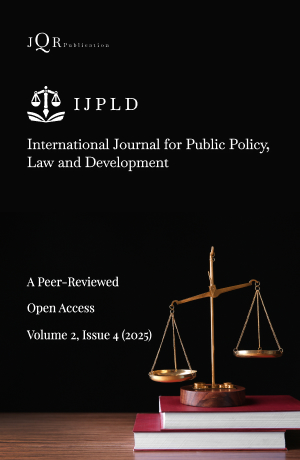U.S. Tax Reform: “The Four Ages Of U.S. International Tax”
Keywords:
U.S. International Taxation, Capital Export Neutrality, Deferral, GILTI, Pillar Two, BEPS, TCJAAbstract
This article traces the evolution of the U.S. international tax regime across four distinct historical periods: the age of benefits (1918–1960), the age of neutrality (1960–1980), the age of competition (1981–1997), and the age of cooperation (post-1998). It examines how foundational principles such as capital export neutrality, residence-based taxation, and anti-deferral measures have shaped legislative enactments from the Foreign Tax Credit of 1918 through the Tax Cuts and Jobs Act of 2017. While the framework has succeeded in balancing double taxation relief and U.S. business competitiveness, longstanding features like deferral and check the box elections have facilitated base erosion. The paper highlights the resilience of these core structures despite global reforms, questioning whether the U.S. approach remains optimal amid OECD Pillar Two’s push for minimum taxes. The study provides essential context for understanding current debates on aligning U.S. tax policy with global standards.
References
1. Avi-Yonah, R. S. (2008). Allocating business profits for tax purposes: A proposal to adopt a formulary profit split (Olin Center Working Paper No. 09-003).
2. Avi-Yonah, R. S. (2020). Hanging together: A multilateral approach to taxing multinationals. Tax Law Review, 74(1), 1–42.
3. Berman, D. (2023). U.S. multinationals and Pillar Two: Can the world wait? Tax Notes International, 110(11), 1179–1187.
4. Clausing, K. A. (2021). Fixing GILTI. National Tax Journal, 75(2), 355–390.
5. Clausing, K. A. (2016). The effect of profit shifting on the corporate tax base in the United States and beyond. National Tax Journal, 69(4), 905–934.
6. Desai, M. A., & Hines, J. R. (2004). Old rules and new realities: Corporate tax policy in a global setting. National Tax Journal, 57(4), 937–960.
7. G7 Finance Ministers. (2023, June 21). Communiqué.
8. Graetz, M. J., & O’Hear, M. M. (1997). The original intent of U.S. international taxation. Duke Law Journal, 46(5), 1021–1109.
9. Grinberg, I. (2006). The check-the-box election, entity classification, and international tax planning. Yale Law Journal, 115(5), 1186–1255.
10. Grinberg, I. (2023). The new U.S. tax framework and the OECD Pillar Two model. Tax Notes International, 111(4), 421–430.
11. Internal Revenue Code, 26 U.S.C. §§ 11, 55, 59A, 250, 7701, 904, 951–964, 965, 960 (2018).
12. Internal Revenue Code, 26 U.S.C. § 55 (2022), as amended by the Inflation Reduction Act of 2022.
13. Internal Revenue Service. (2021). Subpart F income and the active financing exception. U.S. Department of the Treasury. https://www.irs.gov (Accessed July 2, 2025).
14. Joint Committee on Taxation. (2022). Background and selected issues relating to the taxation of foreign income of United States corporations (JCX-15-22).
15. Organisation for Economic Co-operation and Development (OECD). (1998). Harmful tax competition: An emerging global issue. OECD Publishing.
Organisation for Economic Co-operation and Development (OECD). (2013). Action plan on base erosion and profit shifting. OECD Publishing.
16. Organisation for Economic Co-operation and Development (OECD). (2021). Tax challenges arising from the digitalization of the economy: Global anti-base erosion model rules (Pillar Two). OECD Publishing. https://www.oecd.org/tax/beps/ (Accessed July 2, 2025).
17. Treasury Regulations, 26 C.F.R. §§ 1.482-1, 1.482-7, 301.7701-3.
18. U.S. Congress. (2017). Tax Cuts and Jobs Act, Pub. L. No. 115-97, 131 Stat. 2054.
19. U.S. Congress. (2022). Inflation Reduction Act, Pub. L. No. 117-169.
Downloads
Published
Issue
Section
License
Copyright (c) 2025 Author

This work is licensed under a Creative Commons Attribution 4.0 International License.
How to Cite
Similar Articles
- Liberty T. Muchimbidzi , Interaction Of OECD Pillar Two Rules with The U.S. GILTI And FDII Regimes (Pre-G7/ US Deal): “A Comparative and Policy Analysis” , International Journal for Public Policy, Law and Development: Vol. 2 No. 5 (2025): International Journal for Public Policy, Law and Development
- María Fernanda Luna Vega, Equity on the Moon and Beyond: Legal Analysis and Proposals for Space Regulation in the 21st Century , International Journal for Public Policy, Law and Development: Vol. 2 No. 3 (2025): Volume 2, Issue 3 International Journal for Public Policy, Law and Development
- Aneesha Singla, Law, Society and Gender Justice: An Analysis of Supreme Court Decision inX V. The Principal Secretary, Health and Family Welfare Department & ANR. , International Journal for Public Policy, Law and Development: Vol. 1 No. 1 (2024): Volume 1, Issue1 International Journal for Public Policy, Law and Development
- Dr. Narender Kumar, Examining Money Laundering Practices through a Legal Perspective: Scrutiny under the ED's Oversight , International Journal for Public Policy, Law and Development: Vol. 1 No. 1 (2024): Volume 1, Issue1 International Journal for Public Policy, Law and Development
- Darina Shamatonova, Are The Existing Cybercrime Offences Effective in Addressing the Challenges Raised By Stealing Data , International Journal for Public Policy, Law and Development: Vol. 2 No. 2 (2025): Volume 2, Issue 2 International Journal for Public Policy, Law and Development
- Emeka Ngige, SAN, Sylvester C. Udemezue, Pedagogical Renaissance: A Disquisition on the Changing Face of Legal Education in Contemporary Nigeria , International Journal for Public Policy, Law and Development: Vol. 2 No. 4 (2025): International Journal for Public Policy, Law and Development
You may also start an advanced similarity search for this article.
Most read articles by the same author(s)
- Liberty T. Muchimbidzi , Interaction Of OECD Pillar Two Rules with The U.S. GILTI And FDII Regimes (Pre-G7/ US Deal): “A Comparative and Policy Analysis” , International Journal for Public Policy, Law and Development: Vol. 2 No. 5 (2025): International Journal for Public Policy, Law and Development

